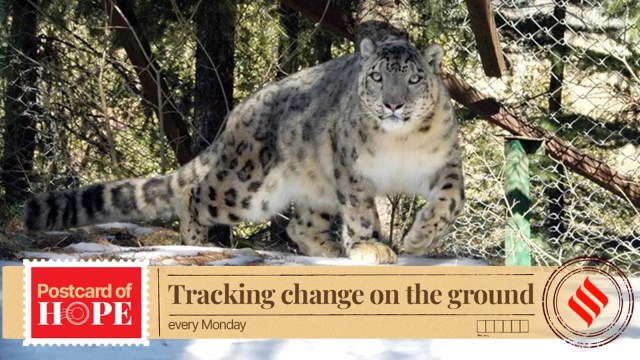How the snow leopard population went up and up in J&K’s Kishtwar national park
After the sightings, wildlife officials estimate that there could be around 100 snow leopards at the national park.
 The snow leopard (Panthera uncia) is listed under the Wildlife (Protection) Act’s Schedule I, which covers endangered species that need rigorous protection.
The snow leopard (Panthera uncia) is listed under the Wildlife (Protection) Act’s Schedule I, which covers endangered species that need rigorous protection.From a first sighting of snow leopards in April 2022 to at least 20 sightings last year, officials have been encouraged by the growing population of the protected species at the High Altitude National Park in Jammu and Kashmir’s Kishtwar.
After the sightings, wildlife officials estimate that there could be around 100 snow leopards at the national park.
The snow leopard (Panthera uncia) is listed under the Wildlife (Protection) Act’s Schedule I, which covers endangered species that need rigorous protection. With a global population of under 10,000, the species is also listed in the International Union for Conservation of Nature (IUCN) red list. Their low numbers and high-altitude habitat make them difficult to count, but according to the Snow Leopard Population Assessment in India, it is estimated that there are 718 snow leopards in the country.
When Ladakh was part of the erstwhile state of J&K, before bifurcation in 2019, it was the only part of the state that had a recorded snow leopard population. After bifurcation, J&K’s wildlife department sought Central assistance to look for leopards in Kishtwar.
Subsequently, 278 camera traps were installed at 135 locations across the national park as part of the first-ever comprehensive survey of snow leopards in Kishtwar. In April 2022, the cameras captured the first officially confirmed sighting of a snow leopard at the park.
Last year, the cameras found several more. “The cameras revealed the presence of approximately 20 individual snow leopards, including an adult with two cubs, confirming breeding within the population of the elusive big cats,” Sajad Zehir, range officer, department of wildlife protection, told The Indian Express.
He said the number of snow leopards is expected to be around 100, with the sightings made so far coming from just around a dozen cameras.
“The actual number of snow leopards will be available after March when most of these solar-powered cameras installed in heavily snow-bound areas are retrieved by officials,” he said.
The High Altitude National Park is spread over 2191.5 sq km in Kishtwar district’s Marwah and Dachhan areas, bordering Ladakh on one side and Himachal Pradesh on the other.
During the survey at the national park, wildlife officials also found pellets of hangul, also known as the Kashmir stag, another endangered species which until now was believed to be found only in Kashmir’s Dachigam national park. A substantial number of ibex, gorals, and musk deer were also found, besides brown bears.
The survey was conducted under the supervision of Dr Tariq Shah, a research associate in the wildlife department. It was conducted by a team comprising Dr Pankaj Chandan from the National Development Foundation Jammu – an NGO – and Dr Muneeb of Mysore-based Nature Conservation Foundation, in collaboration with the Department of Wildlife Protection. Dr Neeraj Sharma, in-charge of the Institute of Mountains and Environment at the Bhaderwah campus of Jammu University, also guided the survey.
Snow leopards are usually found above the tree line on alpine meadows and in rocky regions at elevations of 2,700-6,000 metres above sea level during summer, and at around 1,200-2,000 metres during winter.
The Kishtwar High Altitude National Park is situated at altitudes ranging between 2,300 and 6,000 metres. In India, apart from Kishtwar and Ladakh, snow leopards are also found in high-altitude regions of Himachal Pradesh, Uttarakhand, Sikkim and Arunachal Pradesh.







